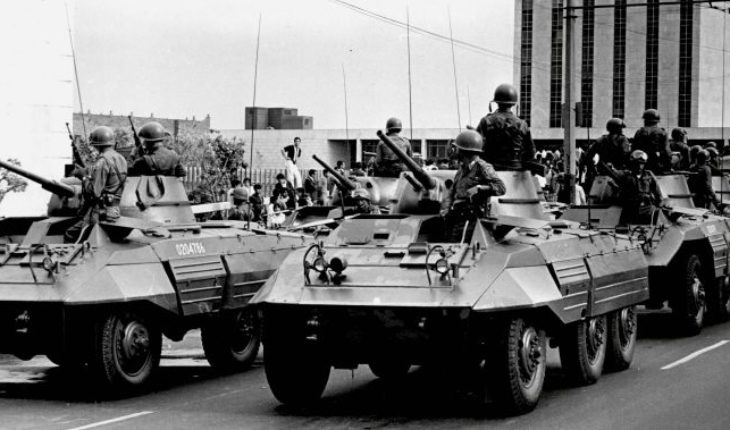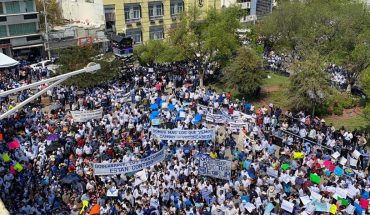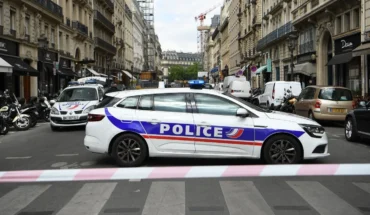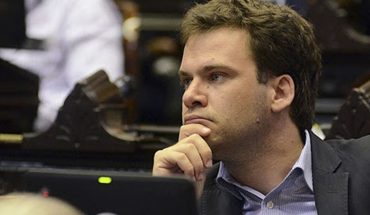editor’s Note: since July 23, Animal politician presents journalistic materials to know facts, names and key moments of the student movement of the 68 who lived in Mexico.
The chronology is published in real time, end to convey the intensity with which they lived those days and is, thus, a better understanding of how it arose and was braked at a very high price the most important social political movement of the 20th century.
It is much to know and understand: 50 years later still do not know why a student Brawl – like many that there were previously – detonated the brutal repression of the Government.
What is true is that the 68 was, is much more than the October 2 massacre. There was a context that explains it. And thats how I present them here.
City of Mexico, October 2, 1968-groupings of regular troop and special military units carried out this morning unusual movements by the Center and North of the capital, hours before a rally takes place in the Plaza of the three cultures of Tlatelolco convened by the National Council of strike (CNH) of the student movement.
Agents of the Directorate of research policies of the Secretary of the Interior reported to his superiors that the army has entered a State of alert special.[1]
various military groups were located in the Chinese clock, the headquarters of the Mexican Trade Union Assembly of electricians, the Plaza of the three cultures, Zacatenco, town of Santo Tomás, Citadel, vocational and high school 4 and University City. The general order was clear: to report three times a day, at 10:00, 12:00 and 14:00.[2]
the official strategy, approved by the head of the Ministry of national defense (Sedena), Marcelino García Barragán, includes a company of the army to occupy several contiguous to the Chihuahua building departments, from the morning overlooking the square of the three cultures, which tonight will host the meeting.
At seven in the morning was a Board of general García Barragán Fernando Gutierrez Barrios, head of the Federal Directorate of security, to coordinate an operation which, it appears, aims to end once and for all with the student movement, just 10 days before the Olympics begin.
Own general told: “in my office, I heard all the reports and asked the captain (Gutierrez) neighborhoods, would we can find in the Chihuahua building some empty apartments where getting a company?”.[3]
Gutierrez Barrios answered the Secretary of defense that would see it, took the phone and talked with general Luis Gutiérrez Oropeza, Chief of the presidential staff; “it happened the headset, and I told Oropeza that I got for the departments that could put a company before two o’clock in the afternoon”.[4]
at approximately 11 o’clock in the morning, they reported him to Garcia Barragan to because there were three empty departments at your disposal: one on the third floor and two more in the fourth floor of the Chihuahua building, the same on whose terrace will be placed speakers at the rally prog ramado for this Wednesday evening.
The Secretary of national defence ordered two of his subordinates who would immediately recognize the Chihuahua building empty departments and were back with the keys at 12:30. They did so. Not only that, also gave instructions that are placed sentries of the military police not to let rise to anyone if it is not with the personal permission of the general García Barragán.[5]
operation Galeana: capturing leaders of the CNH “without firing a single shot” various military groups make movements in various parts of the city, without that, supposedly, some know from each other. At least that is what declared the owner of the Sedena.
In the course of this morning military civilian dresses were distributed in roofs and buildings that overlook the Plaza of the three cultures. They are at least one dozen, they are armed with machine guns and their deployment was ordered by another general: Luis Gutiérrez Oropeza, Chief of the presidential higher State (EMP), according to the report of the Prosecutor for past social and political movements.
One of the knobs of the Estado Mayor Presidencial, the Lieutenant Salcedo, registered elements of that elite group in an apartment of the 13th floor of the mill building of the King, where he lives the Mrs. Rebeca Zuno de Lima, sister-in-law of Luis Echeverría Álvarez, Secretary of the Interior.[6]
the responsibility took it general Gutiérrez Oropeza, so the Secretary of national defense has not been officially learned of these movements.
What is aware the general García Barragán is the Galeana operation, designed to stop all members of the National Council of strike “without firing a single shot” once is carried out the rally to be afternoon in Tlatelolco.
Four military groups moved from the early hours of Wednesday morning in the vicinity of Tlatelolco. The deployment involved the mobilization of between 5 and 10 thousand effective, that have been distributed thus:[7]
clustering number 1: under the command of Colonel Alberto Sánchez López, located in Manuel González and insurgents and consisting of an armoured squadron of Recognition of the 12th Regiment of cavalry, the 40th Infantry Battalion, the 1st Battalion of infantry of presidential guards, as well as two companies of the 19th infantry battalion.
Grouping number 2: under the command of general José Hernández Toledo, located at the monument to the race, consisting of the 2nd recognition, a battalion of Fusiliers parachute armoured Squadron and the 1st Battalion of infantry of the body of guards Presidential.
Grouping number 3: under the command of the Colonel Armando de el Río Acevedo, parked at the Buenavista station, consisting of 44 infantry battalion, an armored squadron of reconnaissance of the 12th Regiment of cavalry mechanics, as well as by the 43rd battalion of Infantry.
And a fourth group of reserve: the Olympia battalion, under the command of Colonel Ernesto Gutiérrez Gómez Tagle.[8]
under the command of the operation Galeana was appointed as the general Crisoforo Mazon Pineda, who will aim to establish a double fence – one external blocking access, in charge of the army, and another inside of soldiers dressed in civilian, belonging to the Olympia battalion-to capture the leaders of the student movement.[9] order of García Barragán was that it should run with all cleaning: no dead or wounded.[10]
is expected to be all preparations ordered by the Mexican Army Chief met to three in the afternoon, a couple of hours until the rally starts: “Captain Careaga was quartered in the Chihuahua building empty departments , with orders to apprehend Sócrates Amado Campos when he was at the microphone; Colonel Gómez Tagle was with his Olympia battalion with your device to cover all the Chihuahua building exits and prevent the escape of the ringleaders”.[11]
[1] not censored report from the Special Prosecutor for social movements and politicians of the past (Femospp). In https://nsarchive2.gwu.edu//NSAEBB/NSAEBB180/index2.htm.
[2] Ditto.
[3] Scherer, Julio, and Monsivais, part of war: Tlaltelolco 1968: general Marcelino García Barragán documents: facts and history, new century / Aguilar, Mexico, 2002.
[4] Ditto.
[5] Special Prosecutor for social movements and politicians of the past (Femospp), op. cit.
[6] Directorate-General for research policy and social, Secretaría de Gobernación, card undated, mentioned in the Special Prosecutor for social movements and politicians of the past, op. cit.
[7] Directorate-General for research policy and social, Secretaría de Gobernación, card 2866, mentioned in the Special Prosecutor for social movements and politicians of the past, op. op. cit., p. 63.
[8] Ditto.
[9] Ditto.
[10] julio Scherer and Carlos Monsiváis, op. cit.
[11] Ditto.





